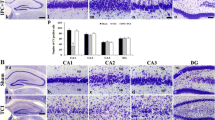Abstract
Ischemic preconditioning (IPC) provides protection against subsequent severe ischemic injury. A recent study found that cerebral IPC prolongs bleeding time. In this study, we examined whether IPC protects against intracerebral hemorrhage (ICH)-induced brain edema formation and whether IPC affects blood coagulation. There were three sets of experiments in this study. In the first set, male Sprague–Dawley rats were preconditioned with either 15 min of left middle cerebral artery occlusion, an IPC stimulus, or a sham operation. Three days later, rats received an infusion of autologous whole blood in the ipsilateral or contralateral caudate. Rats were killed 24 h later for brain water content measurement. In the second set, rats underwent 15 min of IPC or a sham operation. Three days later, rats were used for bleeding and thrombin clotting time tests. In the third set, the levels of p44/42 mitogen-activated protein kinases (MAPKs), heme oxygenase-1 (HO-1), transferrin (Tf), and transferrin receptor (TfR) in the brain 24 or 72 h after IPC were examined. We found that IPC reduced ICH-induced brain edema when blood was injected into the ipsilateral caudate but it did not when blood was injected into the contralateral caudate. IPC resulted in prolongation of bleeding time and thrombin clotting time. IPC also induced the activation of p44/42 MAPKs and upregulation of HO-1, Tf, and TfR levels in the ipsilateral caudate. These results suggest that IPC protects against ICH-induced brain edema formation and decreases blood coagulation. The protection of IPC against ICH is mainly due to local factors in the brain and may be related to activation of p44/42 MAPKs and upregulation of HO-1, Tf, and TfR.






Similar content being viewed by others
References
Qin Z, Song S, Xi G, Silbergleit R, Keep RF, Hoff JT, et al. Preconditioning with hyperbaric oxygen attenuates brain edema after experimental intracerebral hemorrhage. Neurosurg Focus. 2007;22(5):E13.
Hua Y, Keep RF, Hoff JT, Xi G. Thrombin preconditioning attenuates brain edema induced by erythrocytes and iron. J Cerebr Blood Flow Metabol. 2003;23(12):1448–54.
Gidday JM. Cerebral preconditioning and ischaemic tolerance. Nat Rev Neurosci. 2006;7(6):437–48.
Gidday JM. Pharmacologic preconditioning: translating the promise. Transl Stroke Res. 2010;1(1):19–30.
Masada T, Hua Y, Xi G, Ennis SR, Keep RF. Attenuation of ischemic brain edema and cerebrovascular injury after ischemic preconditioning in the rat. J Cerebr Blood Flow Metabol. 2001;21(1):22–33.
Stenzel-Poore MP, Stevens SL, Xiong Z, Lessov NS, Harrington CA, Mori M, et al. Effect of ischaemic preconditioning on genomic response to cerebral ischaemia: similarity to neuroprotective strategies in hibernation and hypoxia–tolerant states. Lancet. 2003;362(9389):1028–37.
Xi G, Wagner KR, Keep RF, Hua Y, de Courten-Myers GM, Broderick JP, et al. Role of blood clot formation on early edema development after experimental intracerebral hemorrhage. Stroke. 1998;29(12):2580–6.
Xi G, Hua Y, Keep RF, Duong HK, Hoff JT. Activation of p44/42 mitogen activated protein kinases in thrombin-induced brain tolerance. Brain Res. 2001;895(1–2):153–9.
Ferris CD, Jaffrey SR, Sawa A, Takahashi M, Brady SD, Barrow RK, et al. Haem oxygenase-1 prevents cell death by regulating cellular iron. Nature Cell Biol. 1999;1(3):152–7.
Connor JR, Menzies SL, Burdo JR, Boyer PJ. Iron and iron management proteins in neurobiology. Pediatr Neurol. 2001;25(2):118–29.
Hua Y, Nakamura T, Keep RF, Wu J, Schallert T, Hoff JT, et al. Long-term effects of experimental intracerebral hemorrhage: the role of iron. J Neurosurg. 2006;104(2):305–12.
Nakamura T, Keep RF, Hua Y, Schallert T, Hoff JT, Xi G. Deferoxamine-induced attenuation of brain edema and neurological deficits in a rat model of intracerebral hemorrhage. J Neurosurg. 2004;100(4):672–8.
Okauchi M, Hua Y, Keep RF, Morgenstern LB, Schallert T, Xi G. Deferoxamine treatment for intracerebral hemorrhage in aged rats: therapeutic time window and optimal duration. Stroke. 2010;41(2):375–82.
Sagher O, Huang DL. Effects of cervical spinal cord stimulation on cerebral blood flow in the rat. J Neurosurg. 2000;93(1 Suppl):71–6.
Karabiyikoglu M, Hua Y, Keep RF, Ennis SR, Xi G. Intracerebral hirudin injection attenuates ischemic damage and neurologic deficits without altering local cerebral blood flow. J Cerebr Blood Flow Metabol. 2004;24(2):159–66.
Murry CE, Jennings RB, Reimer KA. Preconditioning with ischemia: a delay of lethal cell injury in ischemic myocardium. Circ. 1986;74(5):1124–36.
Chien CT, Chen CF, Hsu SM, Lee PH, Lai MK. Protective mechanism of preconditioning hypoxia attenuates apoptosis formation during renal ischemia/reperfusion phase. Transplant Proc. 1999;31(5):2012–3.
Yadav SS, Sindram D, Perry DK, Clavien PA. Ischemic preconditioning protects the mouse liver by inhibition of apoptosis through a caspase-dependent pathway. Hepatol. 1999;30(5):1223–31.
Weih M, Kallenberg K, Bergk A, Dirnagl U, Harms L, Wernecke KD, et al. Attenuated stroke severity after prodromal TIA: a role for ischemic tolerance in the brain? Stroke. 1999;30(9):1851–4.
Clauss A. Rapid physiological coagulation method in determination of fibrinogen. Acta Heamatol. 1957;17(4):237–46.
Keep RF, Wang MM, Xiang J, Hua Y, Xi G. Is there a place for cerebral preconditioning in the clinic? Transl Stroke Res. 2010;1(1):4–18.
Xi G, Keep RF, Hoff JT. Mechanisms of brain injury after intracerebral haemorrhage. Lancet Neurol. 2006;5(1):53–63.
He Y, Hua Y, Liu W, Hu H, Keep RF, Xi G. Effects of cerebral ischemia on neuronal hemoglobin. J Cerebr Blood Flow Metabol. 2009;29(3):596–605.
Loor G, Schumacker PT. Role of hypoxia-inducible factor in cell survival during myocardial ischemia–reperfusion. Cell Death Differ. 2008;15(4):686–90.
Wu J, Hua Y, Keep RF, Nakamura T, Hoff JT, Xi G. Iron and iron-handling proteins in the brain after intracerebral hemorrhage. Stroke. 2003;34(12):2964–9.
Acknowledgment
This study was supported by grants NS-039866, NS-057539, and NS-073595 from the National Institutes of Health (NIH) and 0840016N from American Heart Association (AHA). The content is solely the responsibility of the authors and does not necessarily represent the official views of the NIH and AHA.
Author information
Authors and Affiliations
Corresponding author
Rights and permissions
About this article
Cite this article
He, Y., Karabiyikoglu, M., Hua, Y. et al. Ischemic Preconditioning Attenuates Brain Edema After Experimental Intracerebral Hemorrhage. Transl. Stroke Res. 3 (Suppl 1), 180–187 (2012). https://doi.org/10.1007/s12975-012-0171-z
Received:
Revised:
Accepted:
Published:
Issue Date:
DOI: https://doi.org/10.1007/s12975-012-0171-z




